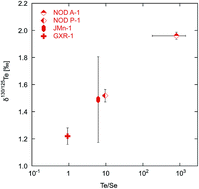当前位置:
X-MOL 学术
›
J. Anal. At. Spectrom.
›
论文详情
Our official English website, www.x-mol.net, welcomes your feedback! (Note: you will need to create a separate account there.)
Precise isotope analysis of tellurium by inductively coupled plasma mass spectrometry using a double spike method†
Journal of Analytical Atomic Spectrometry ( IF 3.4 ) Pub Date : 2018-05-31 00:00:00 , DOI: 10.1039/c8ja00010g Yusuke Fukami 1, 2, 3, 4, 5 , Jun-Ichi Kimura 3, 4, 5, 6 , Katsuhiko Suzuki 1, 2, 3, 4, 5
Journal of Analytical Atomic Spectrometry ( IF 3.4 ) Pub Date : 2018-05-31 00:00:00 , DOI: 10.1039/c8ja00010g Yusuke Fukami 1, 2, 3, 4, 5 , Jun-Ichi Kimura 3, 4, 5, 6 , Katsuhiko Suzuki 1, 2, 3, 4, 5
Affiliation

|
This paper presents an analytical technique to determine the concentrations of Te and Se, and the stable isotope composition of Te. The outlined analytical protocol combines Se single-spike and Te double-spike methods to determine the Se and Te concentrations using the isotope dilution method and mass dependent fractionation of Te isotopes using the double-spike method. Selenium and Te separation from the sample matrix utilized thiol cotton fibre. For the Te isotope analyses, a desolvating nebulizer system (dry plasma) and wet plasma were tested. The reproducibilities of isotope analyses for an in-house standard solution were 0.027‰ and 0.035‰ for δ130/125Te under dry and wet plasma conditions, respectively. The sample consumptions per run for isotope analysis were 20 and 260 ng of Te for the dry and wet conditions, respectively. Correction for the Te hydride ions was necessary for analysis using the wet plasma but not for the dry plasma condition. Barium interferences did not affect the accuracy of the isotope analysis when Ba/Te < 10−2 and <10−3 for either the dry or wet plasma conditions, respectively. We analysed five distinct Te standards, three natural ferromanganese nodule reference materials, and a jasperoid reference material. The measured Te isotope compositions of these samples were identical for the dry and wet plasma setups. Four different standard solutions of Te from different suppliers showed variable Te isotope compositions with a range of 1.25‰ for δ130/125Te, indicating different Te isotope compositions in their source materials and/or that isotope fractionation occurred in their manufacturing processes. A positive correlation was observed between δ130/125Te and Te/Se for the ferromanganese nodules and the jasperoid sample, which potentially suggests that elemental and isotope fractionation of Te occurred simultaneously, and the Te isotope composition may reflect changes in the environmental conditions.
中文翻译:

使用双尖峰法通过电感耦合等离子体质谱法对碲进行精确同位素分析†
本文介绍了一种确定Te和Se浓度以及Te的稳定同位素组成的分析技术。概述的分析规程结合使用硒单峰法和Te双峰法,使用同位素稀释法确定Se和Te的浓度,并使用双峰法对Te同位素进行质量依赖的分馏。从样品基质中分离出硒和Te的方法是使用硫醇棉纤维。对于Te同位素分析,测试了去溶剂化雾化器系统(干式等离子体)和湿式等离子体。同位素的再现性为一个内部标准溶液分析是0.027‰和0.035‰,δ 125分之130Te分别在干和湿等离子体条件下。在干燥和潮湿条件下,同位素分析每次运行的样品消耗量分别为20和260 ng Te。使用湿式等离子体进行分析需要对氢化四氢根离子进行校正,而对于干式血浆条件则不需要校正。当Ba / Te <10 -2和<10 -3时,钡干扰不会影响同位素分析的准确性分别适用于干式或湿式等离子体条件。我们分析了五种不同的Te标准品,三种天然锰铁结核标准物质和一种碧玉标准物质。这些样品的测得的Te同位素组成在干法和湿法等离子体设置中是相同的。来自不同供应商的Te四个不同的标准溶液表明变量TE同位素组合物与一定范围的1.25‰ δ 125分之130碲,表明它们的源材料和/或同位素分馏不同碲同位素组成发生在它们的制造工艺。之间观察到正相关δ 125分之130铁锰结核和碧玉样品中的Te和Te / Se可能暗示Te的元素和同位素分馏同时发生,并且Te同位素组成可能反映了环境条件的变化。
更新日期:2018-05-31
中文翻译:

使用双尖峰法通过电感耦合等离子体质谱法对碲进行精确同位素分析†
本文介绍了一种确定Te和Se浓度以及Te的稳定同位素组成的分析技术。概述的分析规程结合使用硒单峰法和Te双峰法,使用同位素稀释法确定Se和Te的浓度,并使用双峰法对Te同位素进行质量依赖的分馏。从样品基质中分离出硒和Te的方法是使用硫醇棉纤维。对于Te同位素分析,测试了去溶剂化雾化器系统(干式等离子体)和湿式等离子体。同位素的再现性为一个内部标准溶液分析是0.027‰和0.035‰,δ 125分之130Te分别在干和湿等离子体条件下。在干燥和潮湿条件下,同位素分析每次运行的样品消耗量分别为20和260 ng Te。使用湿式等离子体进行分析需要对氢化四氢根离子进行校正,而对于干式血浆条件则不需要校正。当Ba / Te <10 -2和<10 -3时,钡干扰不会影响同位素分析的准确性分别适用于干式或湿式等离子体条件。我们分析了五种不同的Te标准品,三种天然锰铁结核标准物质和一种碧玉标准物质。这些样品的测得的Te同位素组成在干法和湿法等离子体设置中是相同的。来自不同供应商的Te四个不同的标准溶液表明变量TE同位素组合物与一定范围的1.25‰ δ 125分之130碲,表明它们的源材料和/或同位素分馏不同碲同位素组成发生在它们的制造工艺。之间观察到正相关δ 125分之130铁锰结核和碧玉样品中的Te和Te / Se可能暗示Te的元素和同位素分馏同时发生,并且Te同位素组成可能反映了环境条件的变化。


























 京公网安备 11010802027423号
京公网安备 11010802027423号